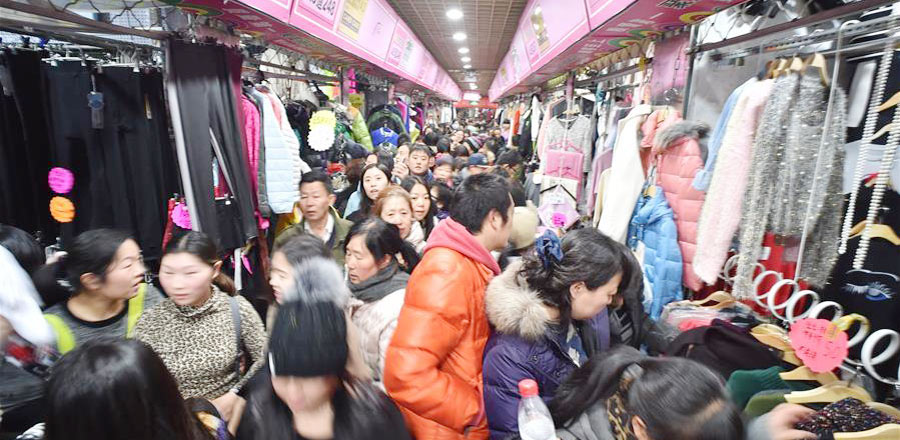
While the annual Shanghai Fashion Week has grown significantly over the years, industry veterans believe more needs to be done before it can be on par with its more illustrious Western counterparts
The front row at the opening show of the 2016 Fall/Winter Shanghai Fashion Week on April 8 was graced by some very influential people in the global fashion scene, an indication that the annual event has grown much in stature since its inception in 2003.
But instead of the typical personalities like supermodels or A-listers, among those seated were Pascal Morand, executive president of the French Federation of Fashion, Carlo Capasa, chairman of the Italian National Fashion Chamber, Sara Maino, senior editor of Vogue Italy, and Gemma Williams, British fashion columnist and the author of Fashion China. "These are industry veterans who are just as influential, if not more, as fashion designers, stylists and celebrities in the industry," said Du Wenxia, a member of the Shanghai Fashion Week organizing committee.
Ever since the first SFW, the government-sponsored event has strived to narrow the gap with the Big Four - London, Milan, Paris and New York - by inviting famous designers such as Vivienne Westwood and Karl Lagerfeld to reproduce their shows in Shanghai.
The committee had also decided in recent years to shift the focus away from the glamorous side of the event and instead concentrate on "experiences and lessons", according to Chen Ying, vice-president of Shangtex Group, the State-owned company that organizes SFW every year.
After reaching a long-term and strategic cooperation agreement with the British Fashion Council last year, the company has further expanded its European connections this year by signing collaboration deals with the French Fashion Federation and the Italian National Fashion Chamber.
At the news conference on the morning after the opening show, Chen noted that these collaborative deals connect what could be the world's largest consumer market for fashion to a highly established and reliable supply for fashion, as well as "encourage dialogue between young designers and share information among the world's leading fashion manufacturers".
Raymond Tan, a Malaysian fashion photographer who has lived and worked in London for 10 years, said that Shanghai's fashion industry is now the best place in the world to work in.
"The growth of the industry here is amazing and to be a part of the industry when it's growing is what excites me," said Tan, who recently relocated to Shanghai to further his photography career.
"Just look at the sheer number of Chinese graduates in London. Many of them are coming back to China afterwards, and they are the future of not only fashion but also the creative industry here," he added.
But while Shanghai's fashion scene has grown considerably through the years, the industry experts in attendance at SFW noted that there is still much to be done before Shanghai can be considered the world's fifth fashion capital.
"The products are of course important, but that is just one spectrum of the fashion system," said Capasa after the news conference.
"What is missing here in Shanghai is the image of fashion. Image is what aspires women to walk into the store and pay for a dress even though they already have a full wardrobe of it," he added.
In order to achieve this, Capasa said that Shanghai needs to be more open to international collaboration with photographers, stylists and artists.
"Creating image is hard work. It's not something you can walk into a store and ask to buy one kilogram of. Chinese investors are very generous when it comes to buying machines to produce clothes, but what the market needs are masterpieces," said Capasa.
On the other hand, Sara Maino believes that it is the lack of sales technique and the high prices of Chinese creations that have been hindering the progress of China's young fashion designers.
For years, small-scale production, the rising cost of labor in the domestic market and the lack of support have pushed many Chinese designers to set their prices at almost the same level as global luxury brands, and this has in turn isolated them from customers.
Lin Jian, one of China's most celebrated fashion commentators, attributed this to the fact that Chinese designers have been overly obsessed with being "independent". He noted that there is usually a misconception among domestic designers that being independent equates to being successful and stylish. "People often ask when China will produce its own Alexander McQueen or Coco Chanel. I have no answer to that. However, young designers need to face the realities first," said Lin.
xujunqian@chinadaily.com.cn
Facts and figures of this year's Shanghai Fashion Week
49 fashion shows in nine days
Held across four locations: The black tent at Xintiandi (for independent designers and commercial brands), Shanghai Exhibition Center (for international brands such as DIESEL and Dirk Bikkembergs), Labelhood on the Bund for still presentation, and 800 Show in Jing'an for graduates and kids wear.
There were more than 1,500 visitors at the opening day of trade show MODE Showroom, up 30 percent from last season. More than 500 buyers and distributors from around the world attended the four-day event.













